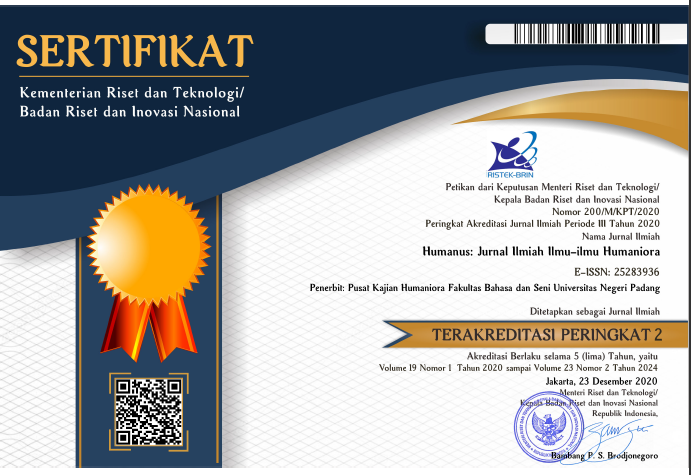The Divergent of Ideational Metafunction Realizations in Novel Graphic Translation
 ), M.R Nababan(2), Riyadi Santosa(3),
), M.R Nababan(2), Riyadi Santosa(3), (1) Universitas Sebelas Maret
(2) Universitas Sebelas Maret
(3) Universitas Sebelas Maret
 Corresponding Author
Corresponding Author
Copyright (c) 2021 Humanus
DOI : https://doi.org/10.24036/humanus.v20i2.107671
Full Text:
 Language : en
Language : en
Abstract
This article is a translation product oriented study designed to investigate a systemic way of analyzing the divergent of Ideational metafunction realizations in novel graphic translation using Systemic Functional Linguistics (SFL). The objectives of this study are to identify divergent of ideational realizations in the translation and what cause them. The study is a descriptive qualitative with an embedded case study. The linguistics data of this study included all the lingual units of translation namely clauses, phrases and words in the monologue and dialogue of the main character in graphic novel V for Vendetta: Europe After Reign by Alan Moore and David Lloyd. The content analysis is used to determine the divergent of Ideational metafunction meanings in translation by comparing the source texts and target texts. The results show the divergent of Ideational realizations in the translation occur in (1) experiential meaning (transitivity structure and lexical items) (2) logical meaning. The divergences in transitivity structure and lexical items are caused by idiom phrases, politeness strategy, and intertextuality. The logical subtype divert in clauses interdependency which caused by two factors namely (1) the translation not maintaining the structure of the source language by downgrading in clause rank and (2) the limitations of the speech balloon format.
Keywords
References
Aghagolzadeh, F. (2012). The Analysis of English-Persian Legal Translations Based on Systemic Functional Grammar Approach (SFG). Theory and Practice in Language Studies, 2(1), 126-131.
Alaei, M & Ahangari, S. (2016). A Study of Ideational Metafunction in Joseph Conrad’s “Heart Of Darkness”: A Critical Discourse Analysis. English Language Teaching, 9(4), 203-213. http://dx.doi.org/10.5539/elt.v9n4p203
Bilal, A.H. (2012). Analysis of Thank You M‟am: Halliday‟s Metafunctions. SAVAP International, 2(1), 726-732.
Borodo, M. (2015). Multimodality, Translation and Comics. Perspectives, 23(1). 22-41.
Celotti, N. (2008).The Translator of Comics As a Semiotic Investigator. In by Zanettin, F (Ed.), Comics in Translation (pp.33-49). Manchester: St. Jerome.
Coffin, C. (2001). Theoretical approaches to written language – a TESOL perspective. In Burs, A. & Coffin, C. (eds.), Analysing English in a Global Context (pp. 93-122). London & USA: Routledge.
Dallacqua, A. K. (2012). Exploring the Connection between Graphic Novel and Film. English Journal, 102(2),64–70.
Dalimunte, A.A. (2013). English Metafunction Analysis in Chemistry Text: Characterization of Scientific Text. International Journal of English Language and Translation Studies, 1(2), 52-68.
Fadhilia, G & Wulansari, A.A.(2019). Ideational Analysis of Donald Duck’s Comic and Its Translation. METATHESIS: Journal of English Language Literature and Teaching. 3(1), 111-116 http://dx.doi.org/10.31002/metathesis.v3i1.1421
Faroughi Hendevalan, J.A. & Jahangiri N. (2008). Application of Lexical-functional Theory in Designing an English- Persian Translation Machine. Translation Studies Journal. 6(21), 25-47.
Greiffenhagen, C. (2013). Visual grammar in Practice: Negotiating the Arrangement of Speech Bubbles in Storyboards. Semiotica, 2013(195), 127–167 https://doi.org/10.1515/sem-2013-0008
Halliday, M.A.K., & Christian M.I.M. Matthiessen. (2014). Halliday’s Introduction to Functional Grammar. London: Routledge
Hermawan, B. & Sukyadi, D.(2017). Ideational and Interpersonal Meanings of Children Narratives in Indonesian Picturebooks. Indonesian Journal of Applied Linguistics, 7(2), 404-412.
Kim, M. (2010) .Translation Error Analysis: A Systemic Functional Grammar Approach. In Coffin C., Th. Lillis & K. O’Halloran (eds.). Applied Linguistics Methods A Reader (pp. 84-94). London & USA: Routledge.
Manafi Ansari, S. (2004). A Function- Based Approach to Translation Quality Assessment. Translation Studies Journal. 1(4): 31-52
Manfredi, M. (2008) Translating Text and Context: Translation Studies and Systemic Functional linguistics. Vol. 1 Translation Theory. 2.ed. Bologna: Centro di Studi Linguistico-Culturali (CeSLiC). in Quaderni del CeSLiC. Functional Grammar Studies For Non-Native Speakers of English. https://doi.org/10.6092/unibo/amsacta/2441.
Miola, R. S.(2004). Seven Types of Intertextuality. In M. Marrapodi, Shakespeare, Italy, and Intertextuality (pp.13-25). Manchester, New York: Manchester University.
Moore, A. & Lloyd, D. (1988). V for Vendetta. New York: DC Comic.
Moore, A. & Lloyd, D.(2006). V for Vendetta. Jakarta: PT Gramedia Pustaka Utama.
Neil, C. (2013). Beyond Speech Balloons and Thought Bubbles: The integration of Text and Image. Semiotica.2013(197), 35 – 63. https://doi.org/10.1515/sem-2013-0079
Ningsih, E.F, Tallapessy, A & Setiarini, R. (2014). Construing Ideational Meaning in Electronics Devices advertisements in Jawa Pos: Systemic Functional Linguistic Multimodal Discourse Analysis. PUBLIKA BUDAYA, 2(1), 6-14.
House of Commons. (2010).The Gunpowder Plot. House of Commons Information Office Factsheet G8, General Series, Revised September 2010 September.
Serafini, F. (2011). Expanding Perspectives for Comprehending Visual images in Multimodal Texts. Journal of Adolescent & Adult Literacy, 54(5) 342-340.
Thompson, G. (2014). Introduction Functional Grammar. New York: Routledge.
Veroz, M.A. (2017). Translation in the European Parliament: The Study of the Ideational Function in Technical Texts (EN/FR/ES), META. 62(1) 19-44. https://doi.org/10.7202/1040465
Wachidah, S. (2010) Tipe Proses dalam Berbagai Teks dalam Koran Serta Pengungkapannya dengan Kelas Kata Verba Bahasa Indonesia. Linguistik Indonesia, 28(2), 201-217.
Watts, R. J. (2003). Politeness. Cambridge: Cambridge University Press.
Yuhriyah, E. (2014).An Analysis of Ideational meaning in the Evergreen Songs and ts Contribution to the Teaching Narrative Texts. ETERNAL (English Teaching Journal), 5(2), 51-57.
 Article Metrics
Article Metrics
 Abstract Views : 700 times
Abstract Views : 700 times
 PDF Downloaded : 200 times
PDF Downloaded : 200 times
Refbacks
- There are currently no refbacks.
Copyright (c) 2021 Humanus

This work is licensed under a Creative Commons Attribution-NonCommercial 4.0 International License.










